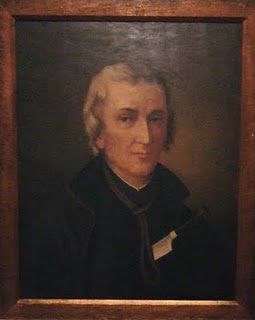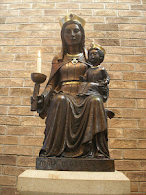
On 25th October 1970, Pope Paul VI canonised 40 men and women from England and Wales who had given their lives for their faith. St David Lewis was the last of the forty to be martyred. Ten of the Forty Martyrs of England and Wales, including St David Lewis, were Jesuits. In this and the next couple of posts, we intend to tell, briefly, their stories. (FOR PART 1, SEE PREVIOUS POST)
3) St Robert Southwell was born in 1561 and sent to Douai while still a child. He remained there for some time and eventually made his way to Rome where he entered the Jesuit Novitiate of Sant’ Andrea. He was ordained in 1584 and, in 1586, he was sent upon the English Mission with Fr Henry Garnet. Robert was a tireless worker in Christ’s vineyard. He was instrumental in setting up a chain of Mass centres, he protected hunted priests, smuggled students for the priesthood abroad, sheltered priests arriving from the continent, and maintained a printing press on which he produced Catholic literature, including his own works. To his enemies he was known as “the chief dealer for the papists in England”. On 20th June 1592, Fr Southwell was apprehended at Uxendon Hall in Harrow, Middlesex. He had been betrayed by the owner’s daughter, Anne Bellamy, after she had been interrogated and raped by Topcliffe, the Queen’s chief priest-hunter and torturer. Fr Southwell was imprisoned in the Tower for three years and questioned under horrendous torture. Finally, shortly before his trial, he was moved to Newgate Prison and thrown into a dungeon called “Limbo”. At his trial in February 1595, he was, predictably, found guilty and sentenced to be hanged, drawn and quartered. The next day, 21st February, the condemned priest was taken to Tyburn for execution. Standing on the cart under the noose, Robert made the Sign of the Cross, though his hands were bound, and began to speak to the assembled crowd. “Whether we live, we live to the Lord: or whether we die, we die to the Lord. Therefore, whether we live or die, we belong to the Lord.” The Sheriff tried to stop him speaking but he was permitted to carry on. When he finished speaking, he again blessed himself and, as the cart was drawn away he prayed in Latin, “Into thy hands, O Lord, I commend my spirit”. The crowd, including many Protestants, would not allow the priest to be cut down until he was dead and for this reason, some of them tugged at his legs to hasten the end of his suffering. When he was dead, the martyr’s body was cut down, disembowelled and quartered and his head displayed to the crowd. Unusually, the traditional cry of “Traitor” was not uttered. St Robert Southwell, S J, was 33 years old.
4) St Henry Walpole, the eldest of a large family, was born at Docking, Norfolk in 1558. He studied at Peterhouse, Cambridge, and, in 1578, went to study law at Gray’s Inn, London. Upon witnessing the martyrdom of St Edmund Campion in 1581, he converted to Catholicism. He went to Douai in 1582 and the entry in the Douai Diary states “On 7th July Mr Henry Walpole came to us out of England, a discreet, grave and pious man”. He remained here until April 1583 when he was sent to Rome to enter the Society of Jesus. On 15th December 1588 Henry Walpole was ordained in Paris. He was not sent on the English Mission until 1593, arriving in Yorkshire on the night of 6th December. Twenty-four hours later he was captured by the authorities. Three days later he was taken to York where, upon admitting that he was a priest, he was committed to York Gaol. On 25th February 1594, he was ordered to be sent to London and he was imprisoned in the Tower for a year. Carvings that he made on the wall of his cell can still be seen in the Salt Tower. While a prisoner in the Tower, Fr Walpole was tortured at least fourteen times. In 1595, the prisoner was sent back to York to be tried. At his trial he refuted the charges against him, replying at one point, “You, my Lords, sit here at present in judgement as men, and judge as such, being subject to error and passion, but know for certain that there is a Sovereign Judge who will judge righteously, whom in all things we must obey in the first place, and then our lawful princes in such things as are lawful, and no further.” As directed, the jury returned a guilty verdict and Henry was sentenced to death for being a priest, at that time considered high treason. On 7th April 1595, Fr Henry Walpole, along with Fr Alexander Rawlins, was taken to the place of execution at Knavesmire, just outside York. Fr Walpole was forced to watch as his companion was butchered and the authorities offered him his life if he would conform. The priest rejected their bribes and climbed the ladder. He asked the prayers of all Catholics present and lifted his eyes to heaven and began to pray. Before he had finished the Hail Mary, he was shoved off the ladder. He was fully conscious when he was dismembered, disembowelled and quartered. Many witnesses were so moved by the saint’s martyrdom that they converted to Catholicism. The Jesuit Martyr, Saint Henry Walpole, was 37 years old when he gave up his life for his faith.








.JPG)

.JPG)



.JPG)


Really interesting, thank you! :)
ReplyDeleteBenson's 'Come rack, come rope' came to mind ...
Welcome Gabriella
ReplyDeleteIt is nice to hear from you & I am happy that you find it interesting. It is funny that you mentioned "Come Rack, Come Rope" as that is mentioned in the next post, "Ten Were Jesuits, Part 3". I hope you will continue to follow. God bless you.